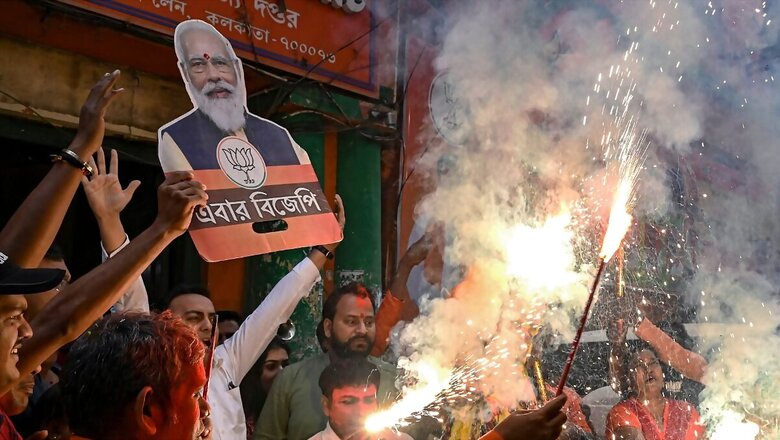
views
With Congress able to secure only Telangana in the four-state elections today, the main narrative of the party built around caste census and alleged deprivation of the OBCs has failed to pick up in the Hindi heartland. Rajasthan, Madhya Pradesh and Chhattisgarh have gone to the BJP in a massive fillip to the party ahead of the next year’s general elections.
Rajasthan, Madhya Pradesh and Chhattisgarh along with Uttar Pradesh and Bihar form the ‘Hindi Belt’ of India. It is also called the states that thrive on Hindutva politics, which includes the issues starting from Ram, Ram Janmabhoomi and cow protection (Gau Raksha).
While the results in Rajasthan are on expected lines as the state has a traditional way of voting for either parties — BJP and Congress — in a cyclic way, it is Chhattisgarh’s numbers, which have completely surprised and overwhelmed all including psephologists and six pollsters. Even though the outcome in Madhya Pradesh was also not predicted the way the numbers are moving, Chhattisgarh has dumbfounded Congress.
Caste Census vs Ram Lalla Pitch
Days after the caste survey was out in Bihar, Bhupesh Baghel’s government was quick to promise the same in his state. Having a majority of OBC and tribal voters, Chhattisgarh was predicted by many to become a caste cauldron. However, the numbers indicate that caste issues did not resonate with the people on ground.
Voters spoke less about the caste issues or about the alleged deprivation of OBCs, but the concern was always about the paddy procurement prices and the pro-farmer policies.
In the past five years, Baghel’s government turned out to be the one that balanced caste, community and religion through his policies and projects. Despite the fact that Bhagel belongs to the Kurmi community, a dominant caste among the OBCs in Chhattisgarh, trends show that the caste narrative has fallen flat in the face of RSS-BJP’s counter campaign.
The counter campaign by the saffron forces and its affiliates accuse the Congress of being “divisive”. The RSS functionaries, who have been working inside the tribal belt in the state, said the caste narrative would not work as the OBC and tribal people know that it was a ploy to divide Hindus. They further said Hindus will only speak about Ram Lalla from now on. They called Ram as the “force that unites all”.
Talking to the News 18, a senior RSS functionary, who was camping in the state for months, said, “We preached for a society where there would not be any caste divide. Bhagwat ji (Mohan Bhagwat) has mentioned it in all his speeches and blamed caste bias for conversion. Lord Rama did not believe in caste, he never divided people. We have been preaching about Ek Mandir Ek Shamsan (one temple, one crematorium) for all. It feels nice to see that our volunteers reached out to the people and carried forward our message,” he said.
“We do not have a problem with the economically backward people getting government benefits, reservation. We do not even have an issue with backward castes coming to the forefront through the government programmes. But one has to see through what the Congress tried. The caste data is available with the government. During the census, the government collects caste data, but it was not made public for a reason,” he added.
BJP’s ‘Rainbow Coalition’, Local Factors Worked
The RSS-BJP leaders say Ram and Ram Janmabhoomi factors caused the saffron surge in Chhattisgarh. However, senior political analysts feel the “rainbow social coalition”, which BJP successfully built in the Hindi heartland worked in their favour.
Senior political analyst and national coordinator, Lokniti Network, Sandeep Shastri told News18, “In the three states of central India, there has been a significant shift of tribal votes in favour of the BJP. The rainbow social coalition, that was built by the BJP by including upper caste, backward caste and the tribal, seems to have worked in favour of the party”.
“Meanwhile, the narrative of implementing a caste census did not seem to have cut much ice in the region. Across these three states, the local factors inherently and essentially shaped poll results,” Shastri added.
Turned the Tables
In 2018, the BJP in Chhattisgarh was reduced to 15 seats while the Congress swept the state with 70 seats. In the 90-seat Chhattisgarh, smallest among the four Hindi heartland states, 29 are reserved for Scheduled Tribes while 10 are marked for Scheduled Castes. The state has 43% of OBC population, according to a survey by the state government.
BJP witnessed a steep drop from 49 seats in 2013 to 15 seats in 2018 and further down to 13 post bypoll, while Congress surged in numbers. The Congress took its seat tally from 39 seats in 2013 to 68 seats in 2018 and further up to 71 after the bypoll.
As of the current numbers in terms of the leads the parties have in seats today, BJP looks to have an edge over Congress in 56 seats, while Congress is leading in 34 seats. This means, the Congress numbers have halved in the state.















Comments
0 comment